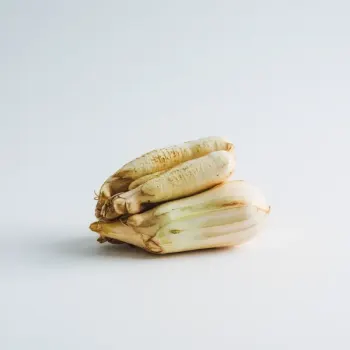Galangal and ginger are aromatic rhizomes used in cooking, with galangal having a sharp, citrusy flavor, ideal for Southeast Asian dishes, and ginger offering a warm, spicy taste, versatile across various cuisines.

Galangal is a bold, aromatic rhizome related to ginger, with a sharp, citrusy flavor often used in Southeast Asian cooking. Its dense texture makes it less versatile than ginger but indispensable in recipes calling for its distinct taste.

Ginger is a widely used rhizome with a warm, spicy bite that's slightly sweet. Its tender texture and versatile flavor profile make it a staple in many different cuisines, from Asian to Western, in both savory dishes and sweets.
Galangal and Ginger differ in taste, texture, and origin. Galangal has a sharp, peppery flavor with hints of pine, while ginger is more pungent and sweet. Galangal is denser and harder, making it less suitable for grating. Originating from different regions of Asia, they each bring a unique touch to the dishes they're used in.

Your ultimate Recipe Box, Meal Planner, and Cooking Class all in one
Best used in Thai Red and Green curries, Galangal provides a complex flavor foundation. Expect a bold, aromatic presence. Use thinly sliced or pounded into curry pastes for authentic Thai taste. While not traditional, Ginger can add a warm, spicy undertone to Thai Yellow curry. Its softer texture blends well into pastes. Use sparingly to complement, not overpower, the dish.
Galangal shines in soups like Tom Kha Gai, where it imparts a robust flavor that holds up to long cooking times. Slice it thickly to infuse soups and stews without disintegrating. Ginger is perfect for gently spiced soups like Carrot Ginger soup. It offers a warming, zesty kick. Grate fresh ginger for a more pronounced flavor or add sliced ginger for a subtler infusion.
In stir-fries, Galangal should be used in dishes that can handle its stronger flavor, such as Indonesian Beef Rendang. It gives a distinctive edge and should be finely chopped. Ginger is a more common choice for a variety of stir-fries, from vegetable medleys to Ginger Beef. Its flavor complements without dominating. Grate or julienne ginger for quick cooking.
Galangal tea, while not as common, can be a soothing remedy with its intense flavor. Steep slices in hot water and combine with honey to balance its potency. Ginger tea is a popular beverage known for its digestive benefits. Steep grated or sliced ginger in boiling water, adding lemon or honey to taste for a comforting drink.
Both Galangal and Ginger are low in calories and contain compounds that may offer health benefits, including anti-inflammatory and digestive properties.
| Nutrient | Ginger ( per 100g ) | Galangal ( per 100g ) |
|---|---|---|
| Fat | 0.8g | 0.1g |
| Sodium | 13mg | 13mg |
| Protein | 1.8g | 1g |
| Calories | 80 | 45 |
| Carbohydrates | 18g | 11g |
| Dietary Fiber | 2g | 2g |
While ginger can be used as a substitute, it will not replicate the unique flavor of galangal. The dish will take on a different taste profile.
Galangal has a sharp, citrusy, and slightly peppery flavor, whereas ginger is warm, spicy, and a bit sweet.
Galangal is less common in Western countries because it's native to Southeast Asia and is less versatile than ginger in different cuisines.
They can be substituted for each other to some extent, but expect the final dish to have a different flavor profile.
Both should be stored in a cool, dry place. Ginger can also be refrigerated or frozen, while galangal is best used fresh or kept frozen if not readily available.